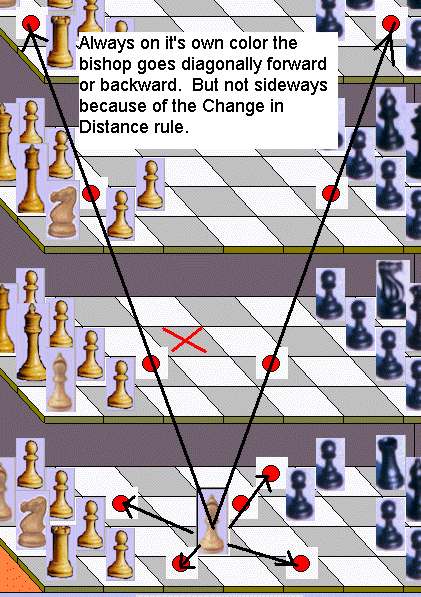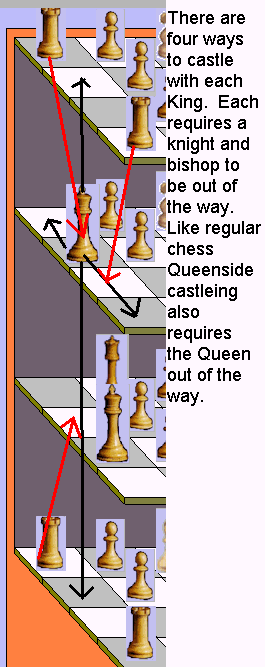Quadlevel 3D Chess
Set up the Board -- (Requires 2 sets of chess men)
Although players are recommended to sit on opposite sides of the long side, with your pieces on the left, play is from the short side vs. short side. Top level -

2nd level -

3rd level -

4th level -

The White Knight goes in the middle short side Top Level White(or clear) square. The Rooks on the short side Top and Bottom level corners. Then a pattern emerges Starting from the rook in the
very first Black corner square on the Top level and continuing in a circle if you will back to that Rook. Rook, Knight, and Bishop - Rook, Knight (Down one level), and Bishop(Down another level) - Rook, Knight, and Bishop Until you reach back to the already placed Rook. The Queens go on there own color in the middle and the Kings next to them. All the pawns go in the front of those pieces.
The Moves
Notation - Naming Moves
In regular chess algebraic has become popular and standard in keeping with that. Just use the same notation just add .. L1 or level 1, or L4 at the end of it. A standard opening moves will be like 1)c4L2 c5L2. For castling say L2O-OL1 - meaning the King on level 2 castled King side to Level 1.

The Change in Distance Rule
In this game I have found a tendency to want to go on some kind of side diagonal. Important to note that in regular chess, when a pawn, bishop, knight, queen(moving like a bishop), or a King(moving like a bishop) moves, it changes distance between one player and his opponent. All of the above mentioned pieces move forward or backward. Another way to look at is if a piece started on the (A) row he must stay on the (A) row when changing boards.
A Pawn, Knight, and Bishop type move must change distance between one players side and the opponents side. Because of this rule all the pieces should be worth the same amount as in regular chess.
Pawn
A Pawn Moves straight toward the opponent. On its first move, a pawn can advance either one or two squares at the players choice, but on all following moves, only one square at a time. If a piece happens to be immediately in front of it, the pawn is blocked and can not advance until that piece gets out of the way. The pawn can capture any opposing piece which appears in the next square diagonally ahead, either to the right, left, up one board, or down one board. If your pawn is on the fifth rank(four moves from its starting point) and an opposing pawn makes a two square move on its direct right, left, up one board, or down one board, then you have one move to capture the opposing pawn as if he had only moved one square (This is called pass pawn or en passant). If one of these weak little men manage to make it all the way to the eighth rank, then you can promote him to either Queen, Rook, Bishop, or a knight.

The Bishop
The Bishop moves only along the diagonal (staying on its own color), but being stronger than the Pawn, he can go backwards as well as forwards. Likewise, in one move, he can go as few or as many squares along diagonal as are vacant. He may capture any enemy piece appearing on same diagonal, providing no other piece lies between captor and captured. In regular chess he can move in four directions, in this game he can move in eight. Think of it this way if he starts on the fourth rank, he goes diagonally to the next row fifth rank, up one level fifth rank, or down one level fifth rank.

The Rook
The Rook moves in a straight line, either across the rows or columns, and changes boards in a straight line. Like the bishop its range is unlimited being able to move back and forth over any number of vacant squares on any horizontal and vertical. It, too, can capture any opposing piece appearing on the same row. Note : Moving the rooks may keep you from castling when needed - see castling under King.

The Queen
She is the most powerful piece on the board, for she has the combined powers of Bishop and Rook. She can move back and forth on the diagonal, like the bishop, and back and forth on the horizontal or vertical.
The Knight
At first the Knights moves seem queer, but youll catch on. Its really a jump over one square, but landing in a square of a different color from the one he left. Thus, if he is on dark, his move will be into light and vice versa. You may also look at it as a L shaped move. 2 Squares or Boards in one direction and one square or board in another. He jumps over pieces, thus you cannot block a knight.

The King
Like the pawn, he can move only one square at a time. But he can go in any direction he likes and can capture any piece appearing in a square adjacent to the one he is occupying. Think of this though your two kings are you, so its best if you keep them safe. You cannot move the king into a square that the enemy can move(Check). If the King becomes "locked" it cannot move either - see "Destroy Both Kings" under checkmate.
Castling
One way to make the King safer and to put a rook into play is to castle. This is a special move in which you are for once allowed to make two moves in one. There are four ways to castle with each King. Two King side and Two Queen Side. In order for this to be legal you cannot have moved the King or Rook involved, and the Knight, Bishop, and sometimes a Queen has to be out of the way. You cannot castle out of Check, into check, or through Check
Kingside

The White King on the 2nd level stays on the same level moves to square a1 on level 2, while the a1 Level 1 rook moves to the position the King was at b1 level 2. 2nd way is King on the 2nd level moves to b1 level 1 and the rook again to b1 level 2. The Knight on b1 level 1 and Bishop on a1 level 2 must already have moved. With the White King on level 3 it is the same except reversed. See diagram below.

Queenside

The White Queen on level 2 moves to the right to d1L2 and the rook at d1L1 comes down to c1L2. 2nd way is to move way down two boards to b1L4 and the rook on a1L4 moves to b1L3. Again the Queen cannot be in your way. For the White King on the 3rd level it is the same except reversed.
Power
It should be the same as regular chess. But logically the Knight may be slightly stronger than the Bishop in this game because of the fact that the bishop can only go 3 squares in any one direction. I havent noticed the difference in practice though.
Pawn - 1
Knight - 3(+)
Bishop - 3
Rook - 5
Queen - 10
Check
Your King(s) is in check when a opposing piece could move and capture the King were it his turn. You must get out of check. You can do this by capturing the piece that is checking, moving the King out of check, or interposing another piece.
Checkmate or Win
There are two ways to play -
Standard
When the King(s) are in check and you cannot make any legal moves then you have lost. When both Kings are in check this is called a double check. You may also resign before you get this far to allow your opponent to win without a fight.
Draw / Tie
Can be agreed upon. Occurs when a position comes up to the same player three times usually in a perpetual check. 50 moves in a row with no Pawn advancement or piece capture. A Stalemate occurs when your King(s) are not in check and you cannot make any legal moves.
Destroy Both Kings
When a King is checkmated, it is removed from the board, but play continues. If a double check occurs or anytime both Kings are somehow involved a decision is made by the player for which King to remove and the other moves to safety. But remember once the one King is off the board the remaining King becomes Stationary, "Locked". Even a Check can be fatal to a Locked King if you cannot interpose or capture the checking piece. That does not mean that the enemy can win by moving his King adjacent to the "locked" King.
Draw
A Draw occurs for all the "Standard" reasons except one. If a Stalemate like position were to occur in which the only piece he could possibly move is the "locked" King. The King will be unlocked for the rest of the game.
Copyright ã 1970 Robert Koernke Sr. "The Complete Rules of Three Dimensional Chess" - with revisions by Robert Koernke Jr.
For more information, visit the Quadlevel page.
 This 'user submitted' page is a collaboration between the posting user and the Chess Variant Pages. Registered contributors to the Chess Variant Pages have the ability to post their own works, subject to review and editing by the Chess Variant Pages Editorial Staff.
This 'user submitted' page is a collaboration between the posting user and the Chess Variant Pages. Registered contributors to the Chess Variant Pages have the ability to post their own works, subject to review and editing by the Chess Variant Pages Editorial Staff.
Author: Robert Koernke Jr. Inventor: Robert Koernke Sr and Robert Koernke Jr.
Last revised by Ben Reiniger.
Web page created: 1970-01-01. Web page last updated: 2022-07-17
